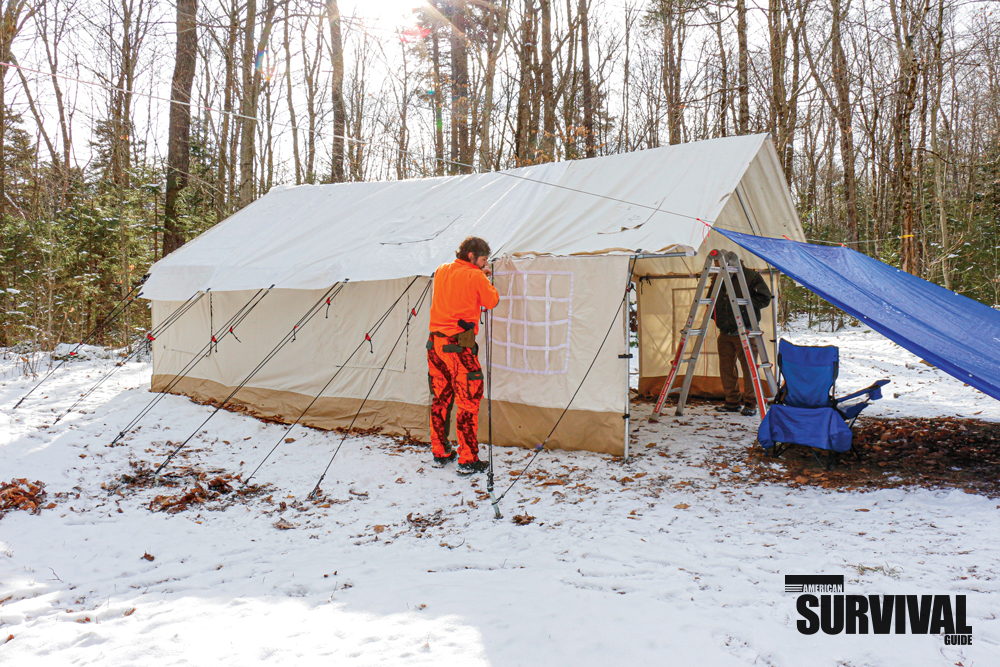A White Duck Outdoors Wall Tent Makes A Great Extended-stay Base Camp.
I now have a mobile base camp… and it fits in the back of my Toyota Rav4: I recently invested in a White Duck Outdoors Alpha Wall Tent.
“Choose a tent too small, and you can feel too crowded if you’re forced inside for long periods during inclement weather. … choose a tent that’s too large, and you’ll have more difficulty transporting it, setting it up and heating it.”
Although this tent is easy to set up, it’s not the type of thing you’d normally bring for a summer weekend campout. This is a four-season tent that’s roomy and comfortable for more-extended stays. (I understand that some “glamping” resorts offer them as an alternative to renting cabins for those who don’t want to rough it.) However, there are other possibilities for this tent as part of an emergency preparedness strategy.
ESTABLISH AN OUTPOST
I bought my tent with the idea of setting it up on state forest land for the duration of the fall deer-hunting season to be used by my brother, his son and me. But, along the way, it occurred to me that this tent would make a good basis for a mobile outpost—a remote refuge for anyone evacuating because of a temporary disaster or, as a last resort, escaping man-made mayhem.
“For those who, like me, don’t happen to own any getaway property, such a tent makes sense. One key advantage is that I’m not locked into a particular location.”
For those who, like me, don’t happen to own any getaway property, such a tent makes sense. One key advantage is that I’m not locked into a particular location. Depending on how far-reaching a critical event happens to be, I have a whole country in which to choose a safe retreat. As a bonus, it incurs no property taxes or property upkeep.
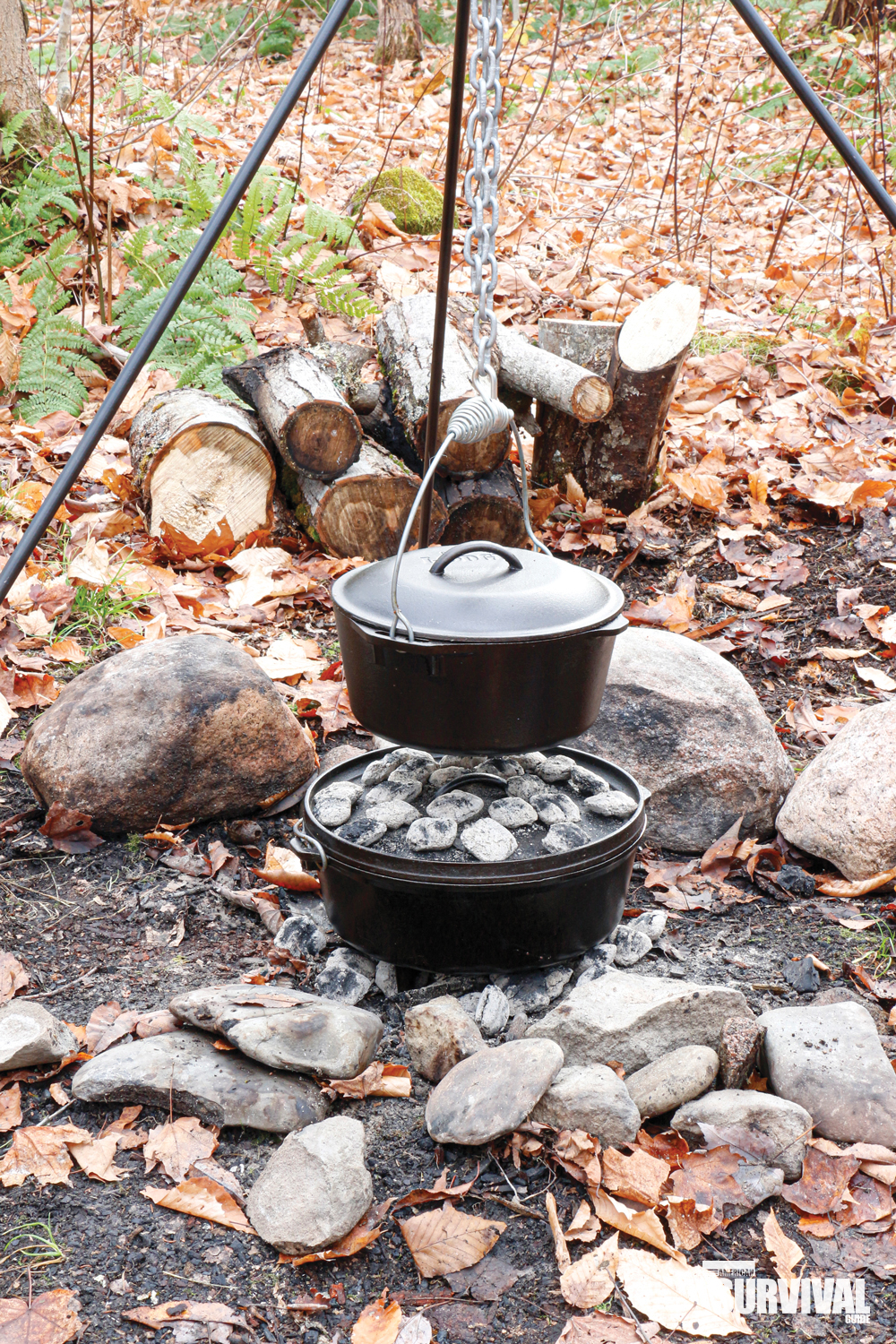
SIZING IT UP
The White Duck Alpha wall tent I chose is the company’s 12×14-foot model.
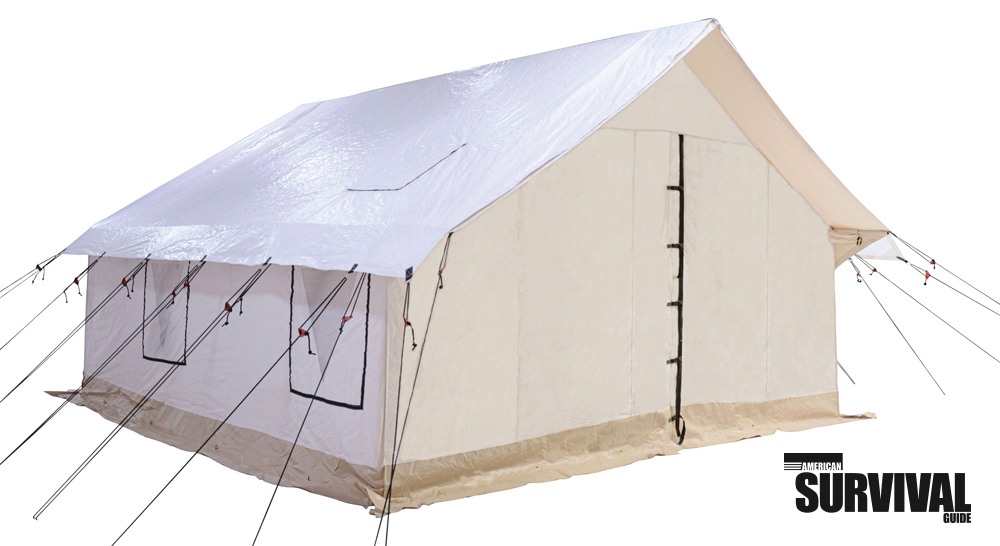
Choosing the size you need can be a tough decision. I wanted it big enough to fit a propane or wood stove and three or four cots for sleeping, along with some spare living space. Choose a tent too small, and you can feel too crowded if you’re forced inside for long periods during inclement weather. I also wanted to be able to squeeze in more people if necessary. But, choose a tent that’s too large, and you’ll have more difficulty transporting it, setting it up and heating it. Obviously, the larger the tent, the higher the cost.
“The benefit of choosing a wall tent is that you have 5-foot-high vertical side walls, so there’s very little wasted space as you’d have with a tepee-style tent.”
The 12×14-foot wall tent gave us plenty of room for the three cots we set inside, but we could have doubled that and then simply folded some of the cots out of the way when they weren’t being used. The benefit of choosing a wall tent is that you have 5-foot-high vertical side walls, so there’s very little wasted space as you’d have with a tepee-style tent. We positioned our cots along the sides and out of the way.
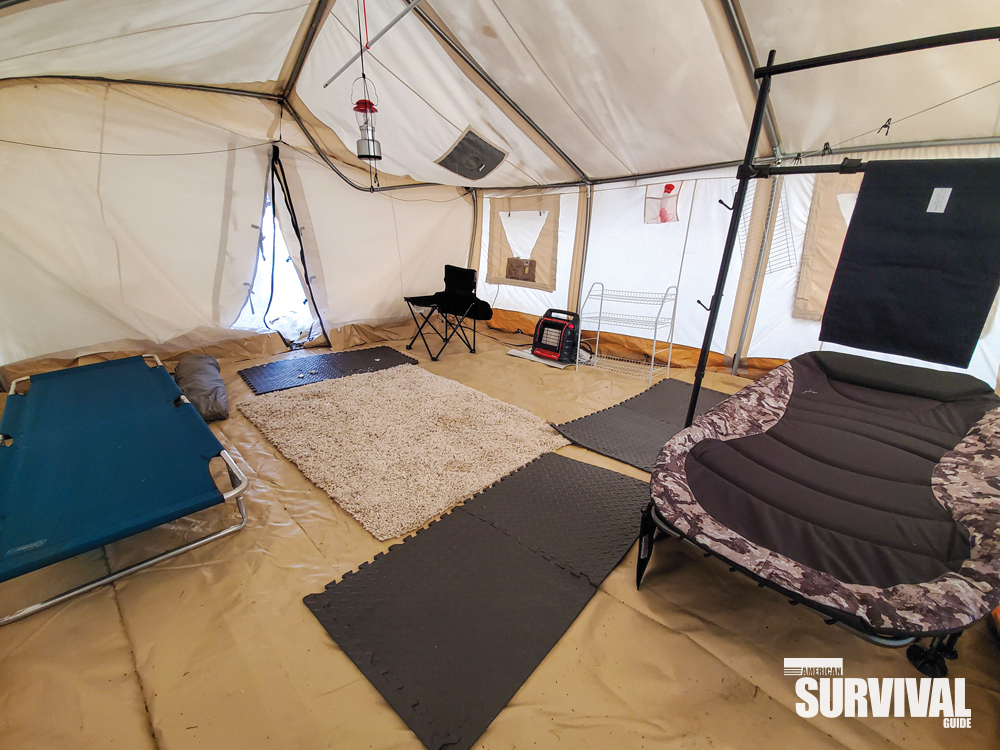
The center height is 8 feet, 8 inches. That provides plenty of headspace for moving around and getting dressed, but it’s also space that can be used to hang lighting and rods to hang clothes. There’s no center pole stuck in the middle to complicate your floor plan.
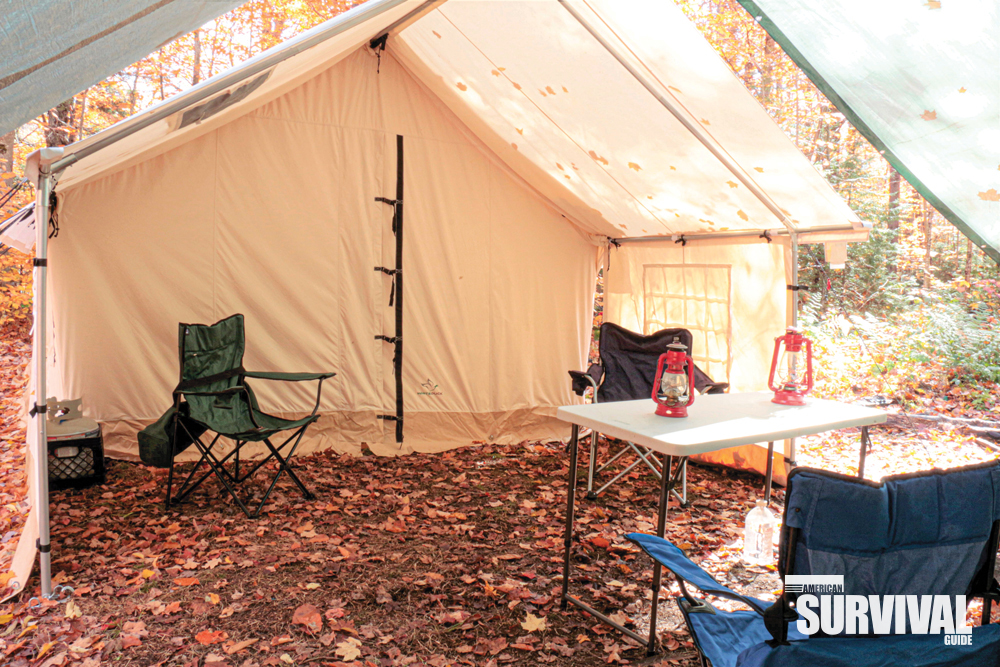
I also purchased the optional porch to be used as our “mud room.” This is an open-front addition to the front of the tent that provides side walls with covered windows and a roof. It provides an additional 7½ feet of space for gear, chairs, a table and such and protects the entryway to the tent from the elements. And, for extra storm protection, I also bought the waterproof fly that covers the tent.
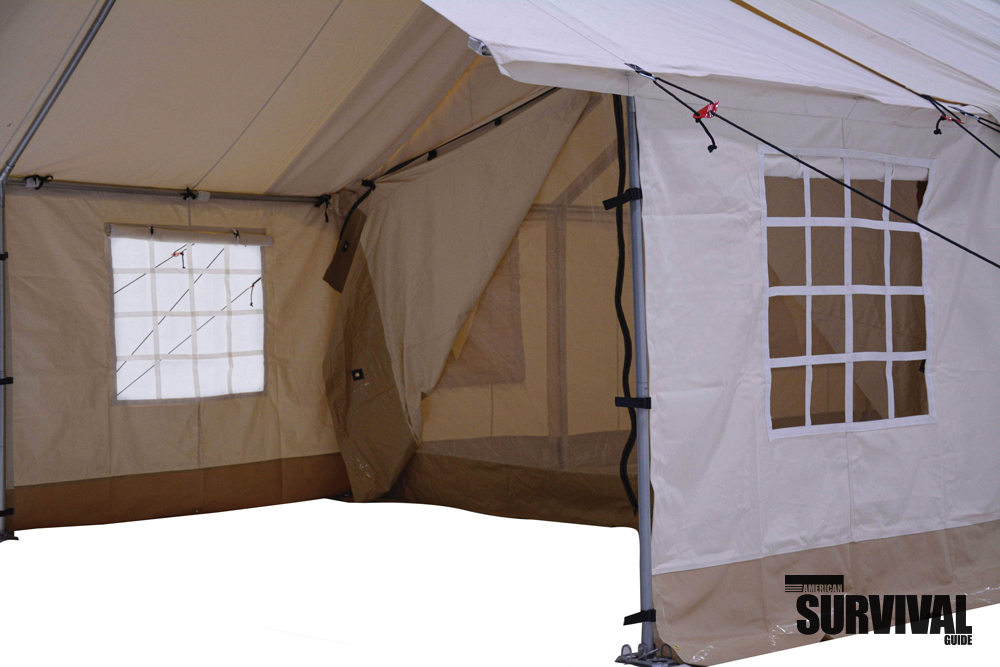
WHITE DUCK CONSTRUCTION
The tent uses a framework of aluminum poles and angled couplers. The uprights have swivel feet on the bottoms to automatically adjust to uneven ground. The tent fabric is white, 100 percent cotton, 10.10-ounce Army duck canvas. It’s heavy-duty material that’s breathable. That limits any condensation problems. And, after getting wet once, the threads in the fabric swell and close together to form a natural water-repellent barrier. All the seams are double stitched, and the corners are reinforced. There’s vinyl mud-flap skirting around the bottom of all the walls where they contact the ground.
“This is a four-season tent that’s roomy and comfortable for more-extended stays.”
The double zippered doors at the front can also be secured with the included quick-release buckles. Zippered mesh behind the doors keeps out the bugs. There are two triangular windows on each of the long sides. They, too, have closures and bug screens. A free-floating ground sheet or sod cloth of 12-ounce PVC provides a waterproof barrier from the ground on the inside. It’s not attached to the tent so that you can remove it for easy cleaning.
The waterproof fly you place over the tent is made of heavy-duty 200gsm polyethylene. There are stove jacks with storm flaps in the roof of the tent, the fly and the porch. They must be cut to the correct size and can accommodate up to a 5-inch stove pipe.
Zippered canvas bags with reinforced waterproof bottoms are included—one each for the tent, the poles and the porch. That makes it easier to transport. The total weight of the tent and poles is approximately 200 pounds. Separating the poles and tent into their own bags divides that weight into two nearly equal bags with carry straps. There’s also a canvas bag for the stakes. A rubber mallet is included for pounding them in.
EASY SETUP
One of the main motivators for buying this tent is that I wanted something that was easier to set up and take down than the old military tent, which required an army to maneuver and erect! One person, alone, could probably set up the White Duck Alpha tent. Two people will have no problem; three are even better (unless one tends to be a little bossy. I won’t admit to that!).
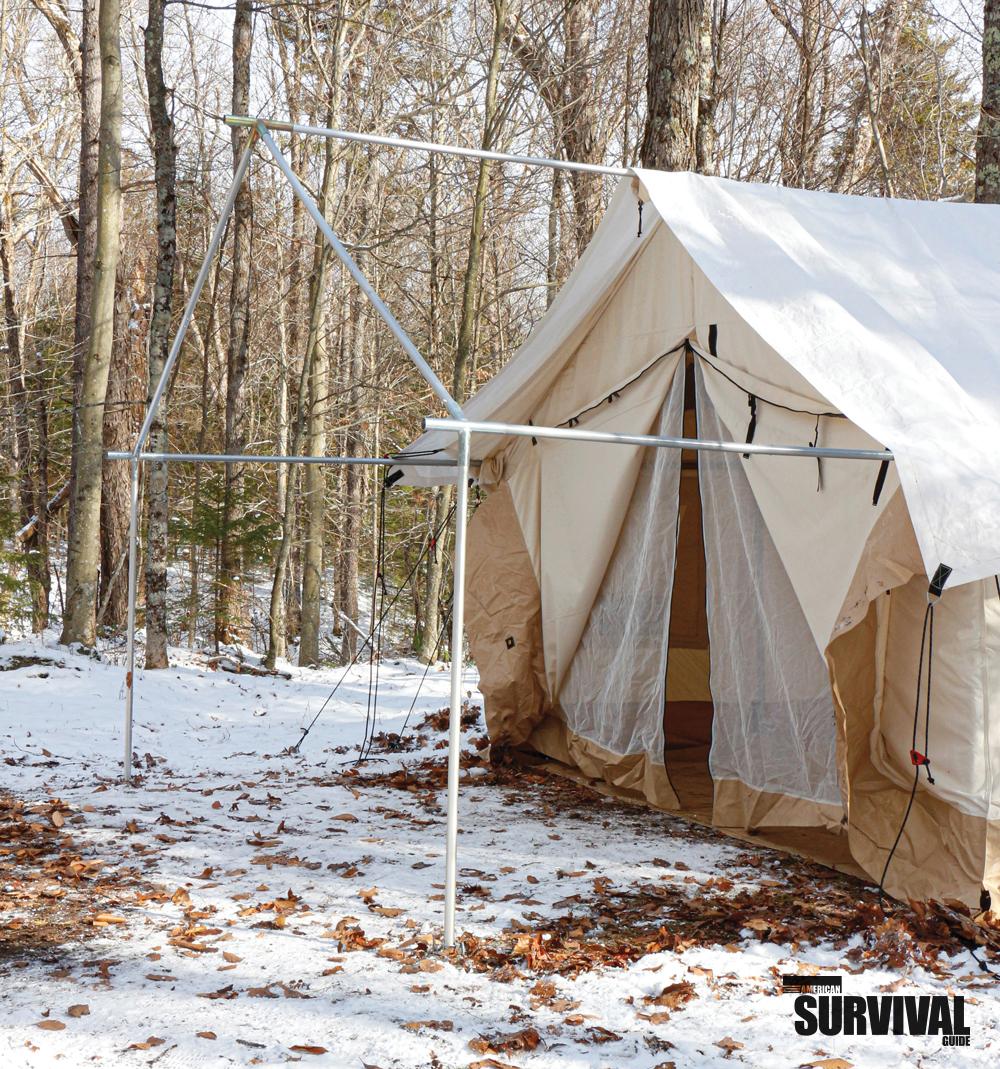
The instructions that came with the tent are easy to follow. Even so, the White Duck website offers a video that takes you through the setup process step by step, and it’s worth watching before setting up your tent for the first time.
“With a wall tent, you can establish a home-away-from-home that can be moved easily from one location to another as needed, without requiring a tractor trailer to do it.”
The tent frame is erected first, but without the uprights for one side. This keeps the frame low enough for you to drape the tent over the frame without needing a ladder. Once the tent is over the frame, the remaining uprights are put into place, and the poles, tent and guy lines are staked down. The fly goes over the top. The fly’s guy lines can be attached to the same stakes as the tent lines. There are line adjusters to keep things taut all the way around.
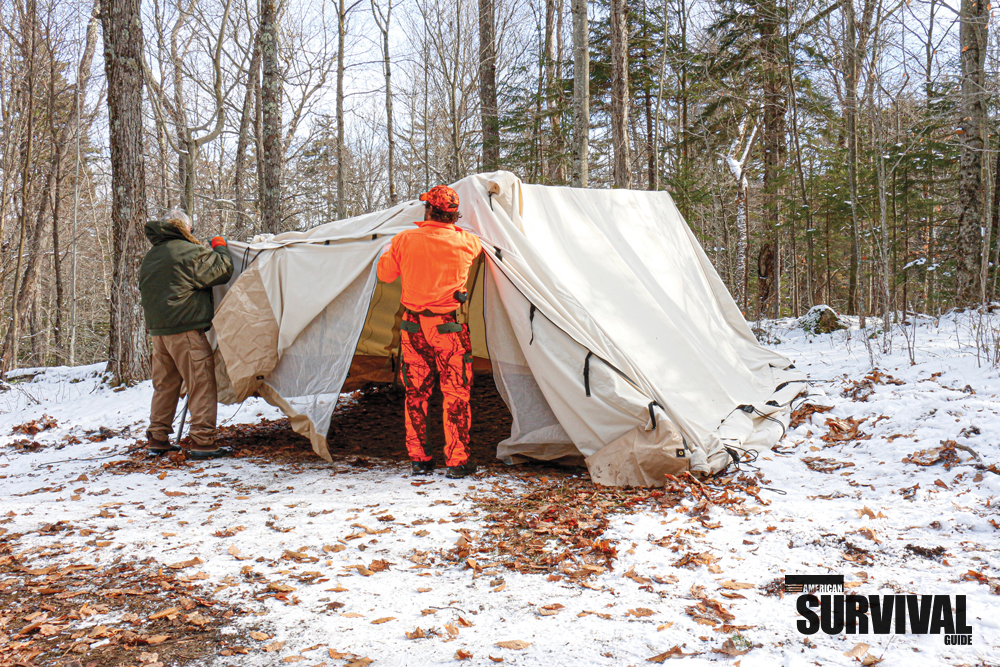
MAKING IT A HOME
Across from the wall tent, we put up an old tent that had been used for family camping trips when I was a kid. We ran a steel cable over everything to suspend tarps for extra protection. In the space between the tents, we put up a couple of portable tables and some folding camp chairs. This was to be our open-air dining area. We had a two-burner Coleman gas stove and a nearby fire pit for cooking with Dutch ovens and a grill top. The old tent was our overflow area for gear and guests or if foul weather forced us inside to eat. We kept all food out of the new wall tent to keep out the critters, big and small alike. The food usually went into our vehicles. Even so, we stored it in buckets or bins with tops, because mice sometimes hitch a ride and find a way in.
“A free-floating ground sheet or sod cloth of 12-ounce PVC provides a waterproof barrier from the ground on the inside. It’s not attached to the tent so that you can remove it for easy cleaning.”
In the wall tent, we placed a small area rug that’s perfect for walking around in stockinged feet after logging miles in hunting boots all day. This first season, we used a propane heater to heat the tent before we went to bed and again the first thing in the morning after climbing out of our sleeping bags. The temperature got down to 24 degrees (F) one night, but the temperature inside the tent was comfortable with just that one propane heater. A propane heater is lighter to pack, and you don’t have to spend time chopping firewood. For a getaway shelter, at least in a wooded area, a stove can make use of a readily available fuel supply.
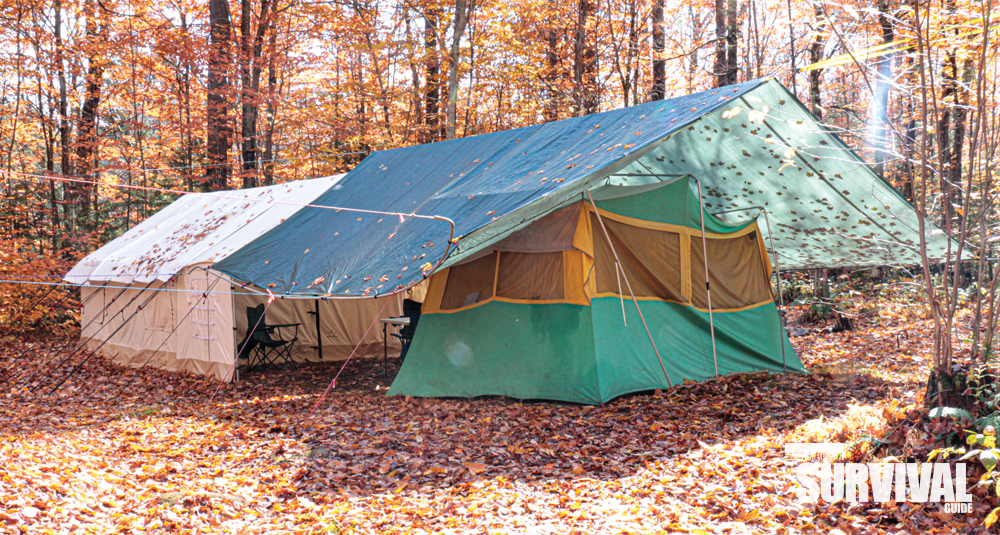
DISASTER HITS
So, everyone lived happily ever after, right? Not in this fairy tale! We’d been away from the camp for a few days, and during that time, an unexpected early-season snowstorm hit the area. It leveled several tent camps in the vicinity, including a good part of ours.
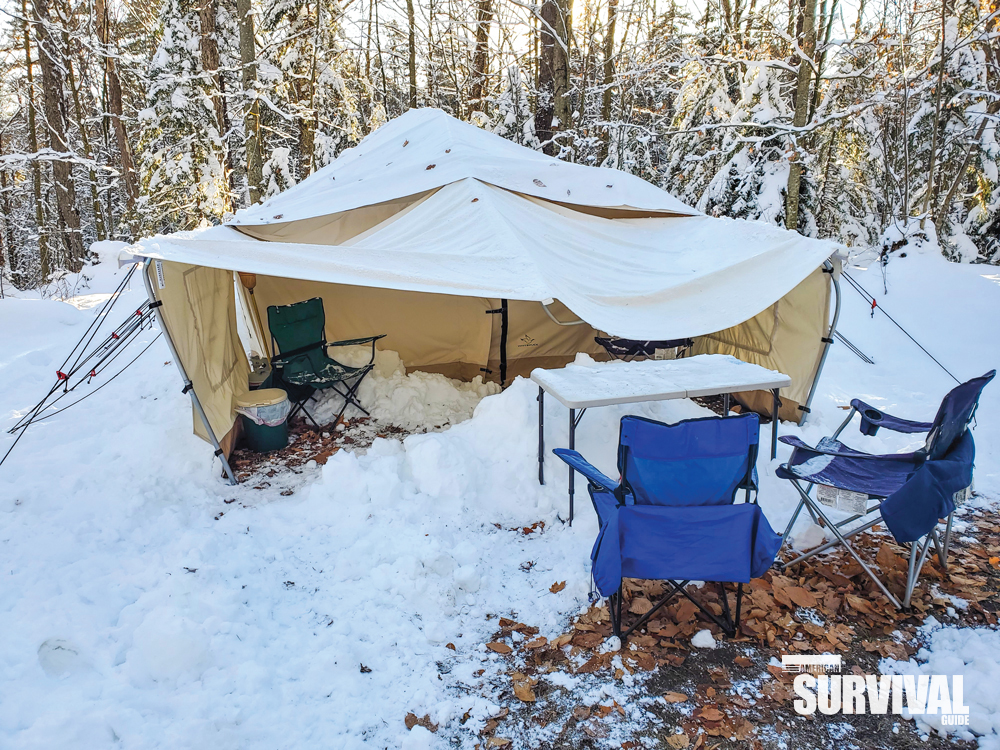
The overhead tarps had sagged, and the snow built up until the steel cable snapped. Down came the snow in an avalanche that crushed our old family tent, the new tent’s porch and the front of the wall tent. About 10 of the poles from the porch and wall tent were severely bent. On the bright side, none of the fabric was torn and, until a new batch of poles arrived, we continued to use the wall tent. Most of the space was still usable.
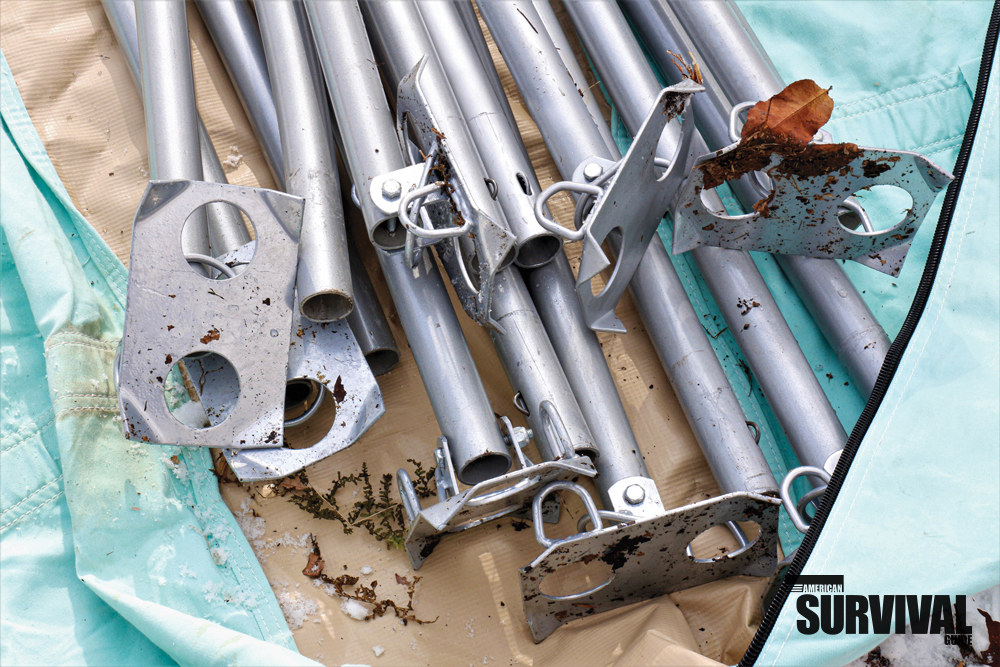
I have to emphasize that this mishap was in no way the fault of the tent, its design or its construction. The fault is in the fact that we were “absentee landlords.” Had we been on-site during the storm, we could have monitored the snow buildup and dealt with it before it got to a critical point. And, in fact, White Duck does offer telescoping poles to reinforce the frame for extra protection against such storms (I think that’ll be next year’s investment).
EASY REPAIRS
Had more of the tent poles been damaged, we could have cut wooden poles to size to fit the couplers as a temporary fix (that’s one more reason to have a good assortment of tools in camp). However, because only the porch and very front of the wall tent were affected, we didn’t bother. When replacement poles arrived, it was a simple matter of “out with the old and in with the new.”
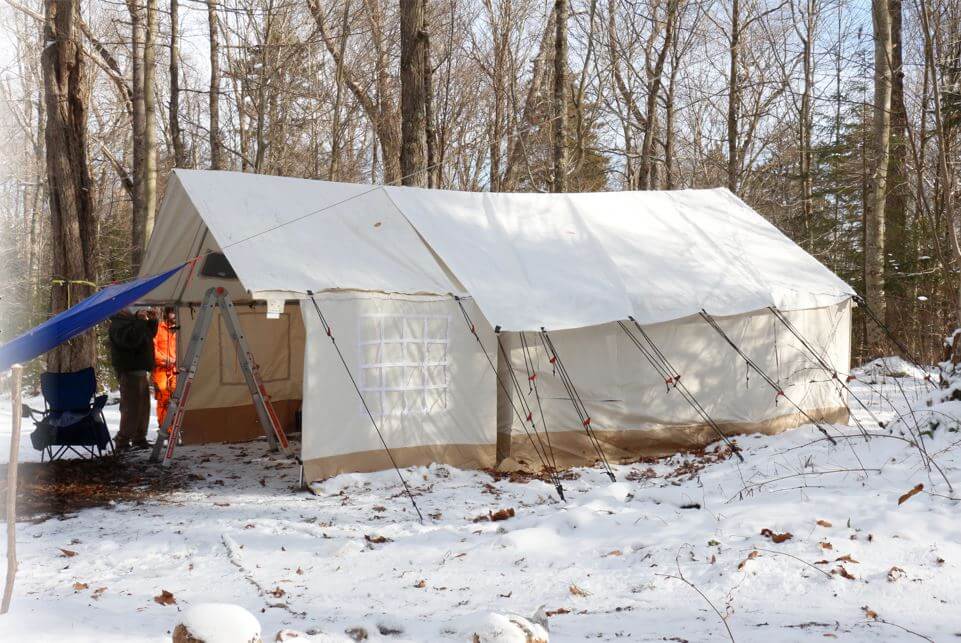
IMPRESSIVE QUALITY
In the wake of most disasters, it’s usually better to stay in your well-supplied home—if possible—with the support of the community behind you. But sometimes, you must evacuate. In addition, a temporary situation can sometimes turn into an ordeal that lasts for weeks. With a wall tent, such as this one from White Duck Outdoors, you can establish a home-away-from-home that can be moved easily from one location to another as needed… without requiring a tractor trailer to do it.
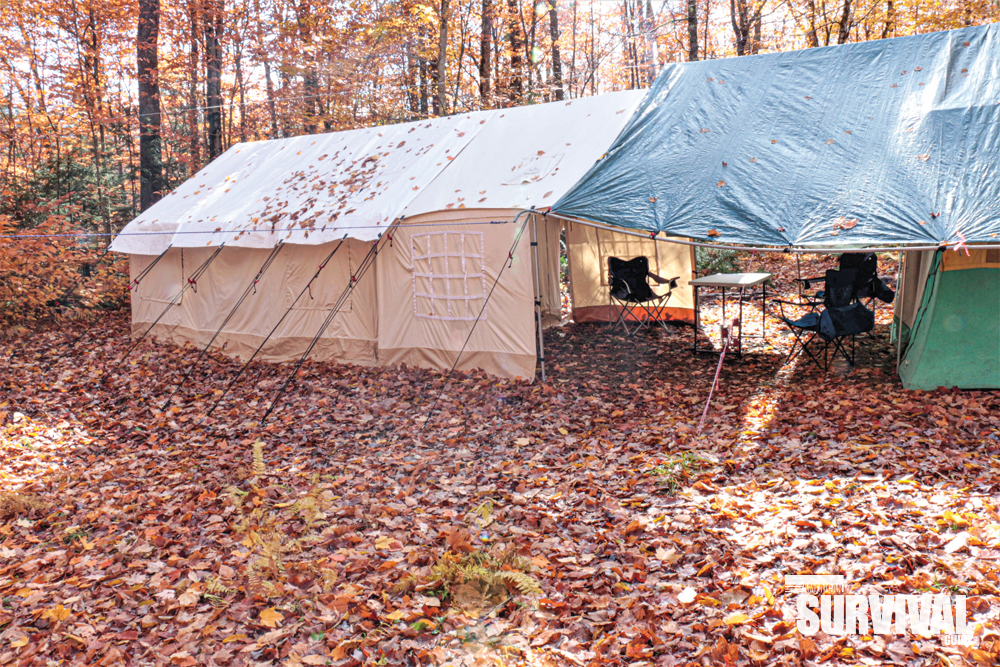
As an added benefit, this wall tent doesn’t have to sit in a corner of your attic, awaiting trouble. You can use it for a hunting camp or for cozy extended vacations.
The quality of the White Duck Alpha wall tent is excellent and, with proper care (don’t store it wet, for instance), it should last for many years–freak snowstorms notwithstanding!
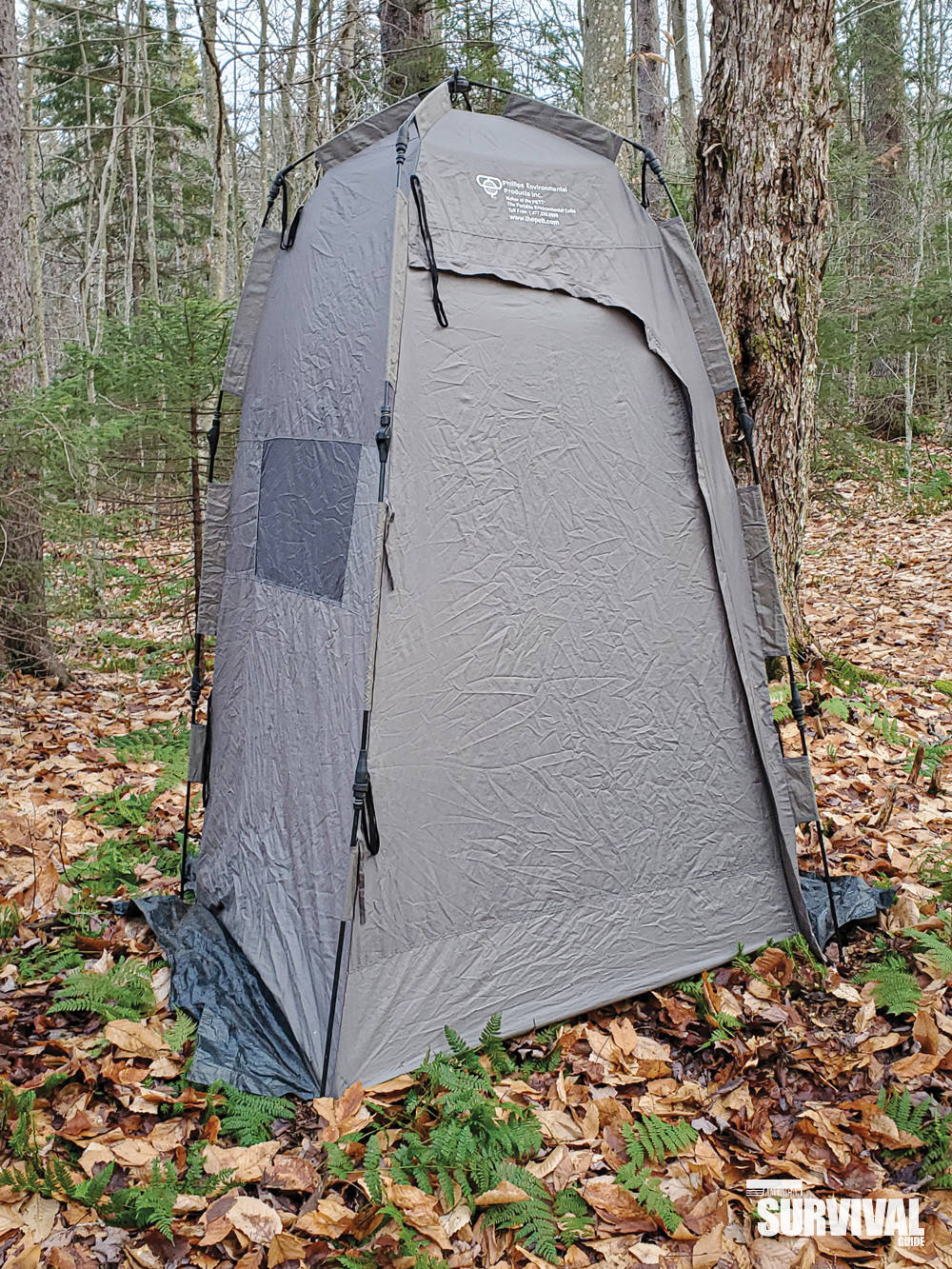
White Duck Outdoors 12×14-foot Alpha Wall Tent
Specifications
Construction: 100 percent cotton, 10.10-ounce Army duck canvas (tent and porch); 200gsm polyethylene (fly); vinyl (sod cloth and mud skirting)
Frame: Anodized aluminum poles, 1.181 inches (diameter)
Weight: Approximately 200 pounds (tent and poles)
MSRP: $1,449.99/12×14-foot tent; $499.99/canvas porch; $300/waterproof fly
SOURCE
White Duck Outdoors
(208) 866-1850
Editor’s note: A version of this article first appeared in the April, 2021 print issue of American Survival Guide.


